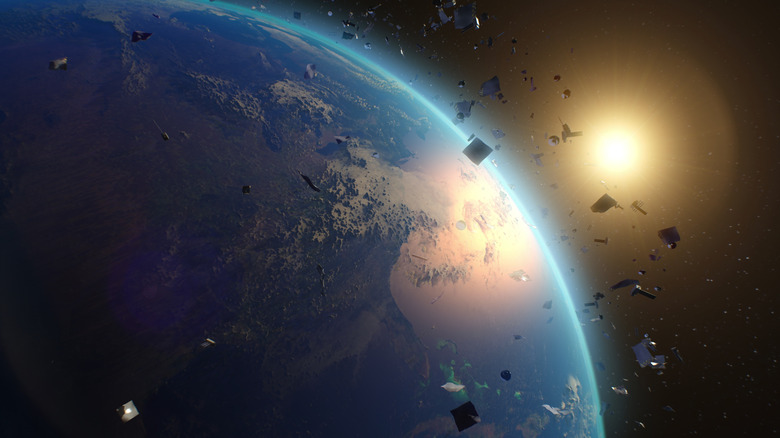Here's How Spacecraft Maneuver Around Space Debris
Space debris exists in huge abundance around the Earth's outer atmosphere and beyond it. Space debris is made up of a variety of different materials, and some is the result of human exploration. Other objects come about as a result of natural collisions, like asteroids, comets, and other natural satellites.
Whether manmade or not, space debris poses an inherent risk to the continued exploration of these outer limits beyond our world. Cal Tech reports that rockets need to attain speeds of around 17,600 miles per hour in order to be put into orbit around the Earth. In comparison, some of Major League Baseball's highest-velocity pitchers can throw just over 100 miles an hour (105.2 is the hardest throw recorded, according to the MLB), and a ball's collision with the batter can result in broken bones or a concussion. Speed this up by about 250 times and the dangers that come along with space travel might begin to be imagined.
It's therefore critical that NASA and other spacefaring agencies around the globe make use of techniques that will protect equipment and personnel from the devastating effects of impact with even some of the smallest pieces of debris that exist out there in the void. Fortunately, some of the brightest minds on our planet work in the field of space exploration and travel, and they've developed a versatile toolbox for dealing with this constant threat.
Complex trajectory calculations and minute maneuvers are crucial
First of all, when launching a new spacecraft into the atmosphere, NASA spends months planning the trajectory in order to ensure a successful lift-off that safely exits the Earth's atmosphere. The project of space travel is underpinned by a vast army of scientists and physicists who spend their days calculating angles and speeds that can produce successful voyages off of the Earth's surface.
But once a spacecraft is out of the atmosphere, even more complex math is required to protect the people and materials on board. Craft like the International Space Station continuously hover above the Earth's surface and play host to a revolving door of astronauts from a number of countries around the world (via NASA). This research laboratory is an essential part of global diplomacy and serves to further our understanding of the universe. But natural and artificial debris can threaten this mission from time to time. In order to keep the ISS safe and functioning, a team of researchers is constantly monitoring an atlas of space debris that exists both in orbit around the Earth and beyond it (via NASA). Mapping these discrete particles is a serious job and calculating their trajectory at any given point in time gives control teams the ability to make course corrections that will bring the ISS, telescopes, and other satellites in orbit out of harm's way. These often include firing boosters to push the craft into a new path.
A growing volume of space debris will continue to complicate evasive measures
While research teams have been successful at protecting the International Space Station and other critical infrastructure in orbit from collisions with debris, this job is only going to get harder over the coming years. There will always be threats from natural debris like comet dust or small meteorite particles, but a growing number of satellites being launched into orbit will continue to make the job of protecting each one of these tools more important and more difficult (via Space). The more infrastructure that is added to Low Earth Orbit, the higher the possibility of unintended collision becomes. If a satellite is destroyed through intentional impact or unintentional collision, it can spread out into thousands of pieces of new debris that must also be added to the tracklist.
The more space junk that collects in Earth's orbit, the more complex these calculations for continued mission success become. Indeed, tracking space debris has become one of the primary mission projects of the U.S. Space Command and the Space Force (even as the Space Command looks to shed this duty to a civilian outlet), according to Space News.
Put simply, evasive maneuvers involve immensely complex mathematics, and success is vital to survival and the continuation of space exploration.


